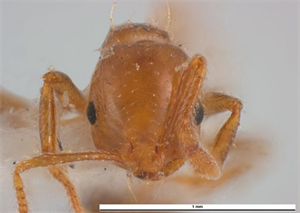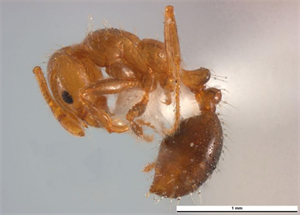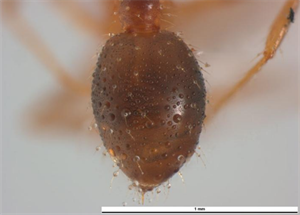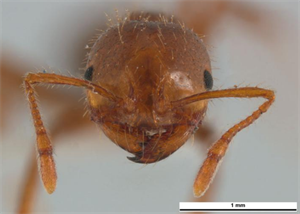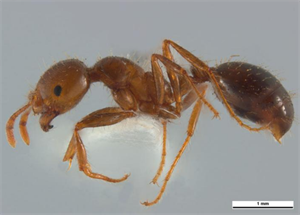- Worldwide distribution. Not recorded from Pacific island countries. Present in Australia (under eradication). Among world's 100 worse invasive species.
- Ground-nesting in sunny agriculture, forest, and grass lands, urban areas. More aggressive and painful sting than tropical fire ant.
- Nests - mounds up to 40 cm, 30-50 cm diameter; entrance holes 5-10 m away. Eat seeds, other insects, smaller vertebrates and honeydew.
- Direct damage: vegetable seeds, fruits, new shoots and roots (large annual costs in US and Australia); loss of biodiversity; indirectly by defending aphids, mealybugs, scales and whiteflies from natural enemies.
- Queens, males and three types of workers: minor, major and intermediate. Nests mostly with 2 or more queens, Up to 500 colonies/ha and each colony 200-400,000. Some with single queens.
- Tramp ant. Spread by queens leaving nest, nuptial flight then new site, or 'budding'; spread via horticultural trade.
- Biosecurity: requires risk assessments, regulations preventing introduction, protocols in case of breaches, and ability to make rapid response. Pacific Ant Prevention Plan available (IUCN/SSC Invasive Specialist Group).
- Natural enemies: several Pseudacteon species under study in USA.
- Cultural control: hot water at 47°C kills ants; over 49°C kills plants.
- Chemical control: use (i) stomach poisons (fipronil, Amdro®, borax), (ii) growth regulators (methoprene, pyriproxyfen), (iii) nerve poisons (bifenthrin, fipronil, imidacloprid). See (http://piat.org.nz/getting-rid-of-ants).
Pacific Pests, Pathogens and Weeds - Online edition
Pacific Pests, Pathogens, Weeds & Pesticides
Red imported fire ant (363)
Red imported fire ant
Solenopsis invicta
AUTHOR Grahame Jackson
Information from CABI (2017) Solenopsis invicta (red imported fire ant). Crop Protection Compendium (https://www.cabi.org/cpc/datasheet/50569); and Pacific Invasive Ant Toolkit. (http://piat.org.nz/); and Solenopsis invicta. AntWiki. (http://www.antwiki.org/wiki/Solenopsis_invicta); and AntWeb. (https://www.antweb.org/description.do?genus=solenopsis&species=invicta&rank=species&resetProject=true); and Solenopsis invicta (2018) Global Invasive Species Database. (http://www.iucngisd.org/gisd/species.php?sc=77); and from Gruber AM, et al. (2021) Predicting socio-economic and biodiversity impacts of invasive species: Red imported fire ant in the developing western Pacific. Ecological Management & Restoration 22(1): 89-99. (https://onlinelibrary.wiley.com/doi/full/10.1111/emr.12457). Photos 1-6 Amy Carmichael (2005) Red imported fire ant (Solenopsis invicta). Queensland University of Technology. PaDIL - (https://www.padil.gov.au/).
Produced with support from the Australian Centre for International Agricultural Research under project HORT/2016/185: Responding to emerging pest and disease threats to horticulture in the Pacific islands, implemented by the University of Queensland and the Secretariat of the Pacific Community.
